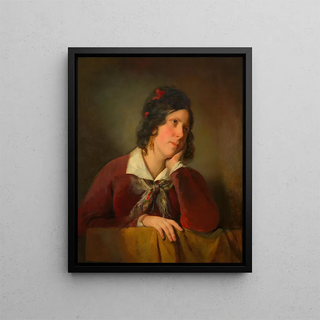Antonie Amerling with her head raised, wife of the artist - Friedrich von Amerling | Art print


View from behind

Frame (optional)
Antonie Amerling with her head raised, artist's wife - Friedrich von Amerling – Captivating Introduction
In the panorama of 19th-century Romantic art, the work "Antonie Amerling with her head raised, artist's wife" by Friedrich von Amerling stands out as a masterpiece, revealing the depth of human emotions and the delicacy of personal relationships. This portrait, which captures the very essence of feminine beauty and conjugal bond, transcends mere representation to offer an intimate reflection on love and admiration. The way the artist immortalizes his muse demonstrates a rare artistic sensitivity, inviting the viewer to immerse themselves in a universe where beauty and tenderness blend harmoniously.
Style and uniqueness of the work
The uniqueness of this portrait lies in the finesse of execution and the poignant expression emanating from Antonie's face. Amerling, master of portraiture, uses a palette of soft and luminous colors, creating a subtle interplay of light and shadow that accentuates her delicate features. The meticulous details, from her carefully styled hair to her elegant clothing, testify to a concern for realism that borders on the sublime. The figure's posture, with her head slightly raised, evokes a certain confidence and introspection, as if Antonie is both aware of her beauty and the feelings her husband harbors for her. This portrait does not merely depict a woman; it tells a story, that of a shared life, deep complicity, and eternal love.
The artist and his influence
Friedrich von Amerling, born in 1803 in Vienna, is one of the most renowned portraitists of his time. His artistic journey is marked by rigorous training and a strong influence from old masters, yet he manages to develop a style that is uniquely his own, combining realism and romanticism. Amerling does not simply paint faces; he seeks to capture the soul of his subjects, to reveal their inner essence. His work is often characterized by particular attention to detail and a constant search for visual harmony. By painting his wife, Antonie, he does not just create a portrait; he immortalizes a

Matte finish

View from behind

Frame (optional)
Antonie Amerling with her head raised, artist's wife - Friedrich von Amerling – Captivating Introduction
In the panorama of 19th-century Romantic art, the work "Antonie Amerling with her head raised, artist's wife" by Friedrich von Amerling stands out as a masterpiece, revealing the depth of human emotions and the delicacy of personal relationships. This portrait, which captures the very essence of feminine beauty and conjugal bond, transcends mere representation to offer an intimate reflection on love and admiration. The way the artist immortalizes his muse demonstrates a rare artistic sensitivity, inviting the viewer to immerse themselves in a universe where beauty and tenderness blend harmoniously.
Style and uniqueness of the work
The uniqueness of this portrait lies in the finesse of execution and the poignant expression emanating from Antonie's face. Amerling, master of portraiture, uses a palette of soft and luminous colors, creating a subtle interplay of light and shadow that accentuates her delicate features. The meticulous details, from her carefully styled hair to her elegant clothing, testify to a concern for realism that borders on the sublime. The figure's posture, with her head slightly raised, evokes a certain confidence and introspection, as if Antonie is both aware of her beauty and the feelings her husband harbors for her. This portrait does not merely depict a woman; it tells a story, that of a shared life, deep complicity, and eternal love.
The artist and his influence
Friedrich von Amerling, born in 1803 in Vienna, is one of the most renowned portraitists of his time. His artistic journey is marked by rigorous training and a strong influence from old masters, yet he manages to develop a style that is uniquely his own, combining realism and romanticism. Amerling does not simply paint faces; he seeks to capture the soul of his subjects, to reveal their inner essence. His work is often characterized by particular attention to detail and a constant search for visual harmony. By painting his wife, Antonie, he does not just create a portrait; he immortalizes a
12,34 €






